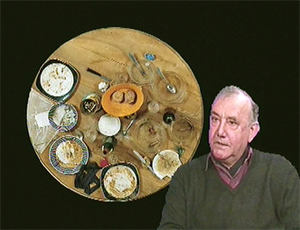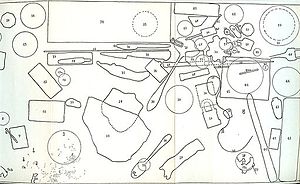- Daniel Spoerri
-
Daniel Spoerri (born 27 March 1930 in Galați) is a Swiss artist and writer born in Romania, who has been called "the central figure of European post-war art" [1] and "one of the most renown[ed] [artists] of the 20th century." [2] Spoerri is best known for his "snare-pictures," a type of assemblage or object art, in which he captures a group of objects, such as the remains of meals eaten by individuals, including the plates, silverware and glasses, all of which are fixed to the table or board, which is then displayed on a wall. He also is widely acclaimed for his book, Topographie Anécdotée* du Hasard (An Anecdoted Topography of Chance), a literary analog to his snare-pictures, in which he mapped all the objects located on his table at a particular moment, describing each with his personal recollections evoked by the object.
Contents
Early life
Spoerri was born Daniel Isaac Feinstein, on 27 March 1930, in Galați, Romania. Although his father, Isaac Feinstein, had converted to Christianity, after Romania entered the War on the side of Nazi Germany he was arrested and killed in 1941. His mother, born Lydia Spoerri, was Swiss and was therefore able to emigrate with her family of 6 children to Switzerland in 1942. There, he was adopted by his maternal uncle and registered as Daniel Spoerri, a name he has retained.[3]
In the 1950s he was active in dance, studying classical dance with Preobrajenska and in 1954 becoming the lead dancer at the State Opera of Bern, Switzerland. He later staged several avant-garde plays including Ionesco's The Bald Soprano and Picasso's surrealist Desire Trapped by the Tail. During that period he met a number of Surrealist artists, including Jean Tinguely, Marcel Duchamp and Man Ray, and also a number of artists subsequently associated with the Fluxus movement, including Robert Filliou, Dieter Roth and Emmett Williams. In the late 1950s, Spoerri married Vera Mertz.[4]
Editions MAT
In 1959 Spoerri founded Editions MAT ("Multiplication d'art Transformable"), a venture which produced and sold copies of three dimensional constructed artworks by artists such as Marcel Duchamp, Dieter Roth, Jean Tinguely and Victor Vasarely. One of the best known works produced by Editions MAT was Man Ray's Indestructible Object. Spoerri is credited with coining the term "multiples" for such works.[5]
Snare-Pictures
In 1960, Spoerri made his first "snare-picture". Spoerri later explained snare-pictures as follows: "objects found in chance positions, in order or disorder (on tables, in boxes, drawers, etc.) are fixed (‘snared’) as they are. Only the plane is changed: since the result is called a picture, what was horizontal becomes vertical. Example: remains of a meal are fixed to the table at which the meal was consumed and the table hung on the wall." [6] One-snare picture, made in 1964, consists of the remains of a meal eaten by Marcel Duchamp.[7] This work holds the auction price record for Spoerri, selling for €136,312 ($200,580) in January 2008, distantly followed by another snare-picture from 1972, which sold for €44,181 ($69,860) in April 2008.[8][9]
An Anecdoted Topography of Chance
In connection with a one man show of his snare-pictures at the Galerie Lawrence in Paris in 1962, Spoerri wrote his Topographie Anécdotée* du Hasard (Anecdoted Topography of Chance). Spoerri was then living at the Hotel Carcassone in Paris, in room number 13 on the fifth floor. To the right of the entrance door was a table which his wife Vera had painted blue. Spoerri drew on a ‘map" the overlapping outlines of all the 80 objects that were lying on the table on 17 October 1961 at exactly 3:47 p.m. Each object was assigned a number and Spoerri wrote a brief description of each object and the memories or associations it evoked. The descriptions cross referenced other objects on the table which were related. The Topographie Anécdotée* du Hasard was printed as a small pamphlet of 53 pages plus a fold out map and index and was distributed as an advertisement for the exhibit.[10] The Topographie Anécdotée* du Hasard is more than just a catalog of random objects, however; read in its entirety, it provides a coherent and compelling picture of Spoerri's travels, friends and artistic endeavors.
The Anecdoted Topography of Chance has been called "arguably the most important and entertaining 'Artist's book' of the post-war period" [11] and a "quasi-autobiographical tour de force." [12] In 1966, the Something Else Press in New York City published an English translation of the Topographie Anécdotée* du Hasard by Emmett Williams, entitled An Anecdoted Topography of Chance (Re-Anecdoted Version). Roland Topor added sketches of each object and additional annotations were added "at random" by Williams and others and by Spoerri himself. A number of appendices were added to the work and a greatly expanded index. The Topographie Anécdotée* du Hasard became a cult classic and was published in German translation by Dieter Roth in 1968 as Anekdoten zu einer Topographie des Zufalls. Roth increased in fact the volume of the book by almost a third by adding his own poetic annotations. In 1990, the original French version was reprinted by the Centre Pompidou in Paris, and in 1995, an expanded English version was published by the Atlas Press in London, with additional material and annotations, and all of Dieter Roth's texts.
New Realism
Spoerri was one of the original signers of the manifesto creating the Nouveau réalisme (New Realism) art movement, an avant garde endeavor formed in 1960.[13]
Fluxus
Spoerri is also closely associated with the Fluxus art movement, a movement formed in the early 1960s, "characterized by a strongly Dadaist attitude, [whose] participants were a divergent group of individualists whose most common theme was their delight in spontaneity and humor." [14] It has been said that his Anecdoted Topography of Chance "seems perfectly to embody aspects of its spirit." [15]
Eat Art
A major theme of Spoerri's artwork is food, and he has called this aspect of his work "Eat Art." This is seen not only in his snare-pictures of eaten meals, but in a variety of other contexts. For example, in 1961 he sold in an art gallery in Copenhagen store bought canned food which he had signed and rubber stamped "Attention: Work of Art." In 1963, he opened the Restaurant de la Galerie J in Paris, an operating restaurant with waiters from the art world. In 1967, Spoerri opened the Restaurant Spoerri in Düsseldorf and in 1970 opened the Eat-Art-Gallery upstairs.[16] He also published in 1970 a diary of his life on the Greek Island of Symi, in which he included numerous recipes of the dishes he ate. Originally titled A Gastronomic Itinerary,[17] it was later republished under the title Mythology & Meatballs.[18]
Subsequent work
Spoerri continued to make snare-pictures, including snares of eaten meals, into the 1990s. He also has created assemblage works, mounting objects on reproductions of 19th century medical illustrations as backgrounds. Spoerri has also produced serigraph and bronze versions of his works.[19]
Spoerri has led a nomadic life, living variously in Bern, Paris, the Greek island of Symi, Düsseldorf, Basel, Munich and Vienna.[16] In 1997 he moved to the Tuscan town of Seggiano where he opened Il Giardino di Daniel Spoerri (the Garden of Daniel Spoerri), a sculpture garden, where works by a number of artists are displayed.[20]
Exhibitions
- 1992: Expo ’92, Swiss pavillon, Sevilla.
- 2001: Museum Jean Tinguely, Basel
- 2009: Ludwig Museum, Koblenz (Germany)
References
- ^ See Coincidence as Master.
- ^ Wieland Schmied and Daniel Spoerri, Daniel Spoerri: Coincidence as Master = Le Hasard comme maître = Der Zufall als Meister = Il caso come maestro, Bielefeld, Germany, 2003 at p. 8, hereinafter "Schmied and Spoerri"
- ^ Schmied and Spoerri, supra, at p. 8; Spoerri, An Anecdoted Topography of Chance (Re-Anecdoted Version), New York, 1966, p. 175, hereinafter "Spoerri 1966".
- ^ Schmied and Spoerri, supra, at p. 144; Spoerri 1966, supra, at p. 175.
- ^ Judith E. Stein, Art in America, July, 2002; Effie Stephano, "Multiples:The First Decade by John L. Tancock" (review) in Leonardo, Vol. 7, no. 1 (Winter 1974), at p. 86.
- ^ Spoerri 1966, supra, at p. 181. They are referred to as "trap pictures" in Schmied and Spoerri, supra, at p. 10.
- ^ Auction by Artcurial - Briest Le Fur Poulain F. Tajan, Jan. 29, 2008.
- ^ Artcurial, The Jean Albou Collection, Jan. 29-30, 2008
- ^ On line subscription service www.askart.com, accessed Mar. 25, 2009. Prices include buyer's premium.
- ^ Spoerri 1966, supra, at pp. xv-xvi.
- ^ Spoerri, 1995, supra, rear cover blurb.
- ^ Peter Frank, Something Else Press: an Annotated Bibliography, 1983, p. 13.
- ^ with Yves Klein, Arman,Cesar, Gerard Deschamps, jacques Villegle, Niki De Saint Phalle .New Realism
- ^ ArtLex on the Fluxus Movement
- ^ Spoerri, An anecdoted topography of chance, Atlas Press, London, 1995, p. 11.
- ^ a b Stein, supra.
- ^ This was included in Spoerri's The Mythological Travels of a Modern Sir John Mandeville, being an account of the Magic, Meatballs and other Monkey Business Peculiar to the Sojourn of Daniel Spoerri upon the Isle of Symi, etc., published by Something Else Press, New York, 1970.
- ^ Berkeley 1982.
- ^ Schmeid and Spoerri, supra.
- ^ Stein, supra, and Il Giardino di Daniel Spoerri
External links
- John G. Hatch, "On the Various Trappings of Daniel Spoerri", a lengthy critical essay on Spoerri
- Daniel Spoerri's site with interactive map of Il Giardino di Daniel Spoerri
- Daniel Spoerri: Coincidence as Master
- Judith E. Stein, Spoerri’s Habitat
- Fribourg Museum with Chronology
- Daniel Spoerri on ArtFacts.net
- (French) Daniel Spoerri
Early precursors Expressionism and Cubism Futurism, Vorticism and Dada Zang Tumb Tumb · Tango With Cows · BLAST · BÏF§ZF+18 · Universal War · Jedermann sein eigner Fussball · An Anna Blume · Russian BalletConstructivism, Surrealism
and ModernismLettrism, Situationism,
Nouveau réalisme
and Arte PoveraYves Peintures · Fin de Copenhague · Mémoires · Zone de Sensibilité Picturale Immatérielle · Linee · DimanchePop Art Fluxus and Conceptual art Literaturwurst · Topographie Anécdotée du Hasard · Water Yam · Grapefruit · Fluxus 1 · Un Coup de Dés Jamais N'Abolira Le HasardArtists' books since 1980 Categories:- Fluxus
- Postmodern artists
- Contemporary artists
- Installation artists
- Conceptual artists
- Swiss artists
- Swiss people of Romanian descent
- Romanian Jews
- 1930 births
- Living people
- Nouveau réalisme artists
Wikimedia Foundation. 2010.


